Rejuvenation
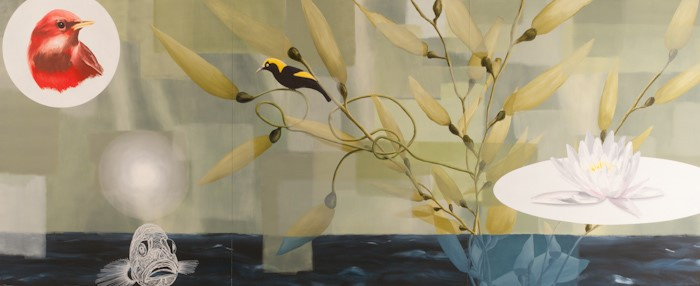
Given That All Things Are Equal, 2009
Oil on panel, 60 × 144 inches
Gift of Merry Karnowsky and James Panozzo
Lisa Adams
Born 1955, Bristol, Pennslyvania
Lives and works in Los Angeles, California
Lisa Adams explores the discord between natural and urban environments in the Los Angeles Basin and Inland Empire of Southern California. She made Given That All Things Are Equal in response to her numerous trips to the Salton Sea, an artificial lake located just southwest of Palm Springs, California. Created by an accidental flooding of the Colorado River in 1905, the Salton Sea ranks as one of the worst agricultural disasters in California’s history. “For me, it has this terrific far away, otherworldly sensation,” remarked Adams. “It feels like a place lost and forgotten but, somehow, in spite of its lack of being cared for, it continues along. In my imagination, it is a glimpse into a place on the earth that exists after human devastation.” Fascinated by nature’s endeavors to flourish after ruin, Adams meticulously rendered flora and fauna with a surreal twist on the illustrations of John James Audubon (1785 – 1851), for whom the nonprofit environmental organization National Audubon Society is named.
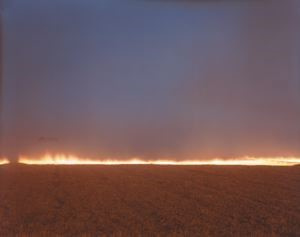
Desert Fire #248, from the series "Canto: The Fires," 1985
Color coupler print, 40 × 50 inches
Gift of Beverly and Peter Lipman
Richard Misrach
Born 1949, Los Angeles, California
Lives and works in Berkeley and Emeryville, California
Richard Misrach traverses the deserts of the American West in search of locations where civilization and nature collide. Though he follows in the tradition of Ansel Adams and Edward Weston, whose twentieth-century landscapes are as much about the beauty of nature as they are about the politics of land use, Misrach (a pioneer of large-format color photography in the 1970s) deals with color and scale to envelope his viewers in a gorgeous visual language that conveys the social, political, and ecological issues of our time.
In the spring of 1983, Misrach witnessed an unexplainable fire in a grove of palm trees near Palm Springs, California. This experience inspired “The Fires” canto—a section of the photographer’s ongoing series “The Desert Cantos”—in which Misrach addressed the phenomenon of flash fires that can be either natural or man-made. In Desert Fire #248, the photographer captured a controlled burn of alfalfa fields—a cost-effective and environmentally friendly method of eliminating unwanted insects and weeds.
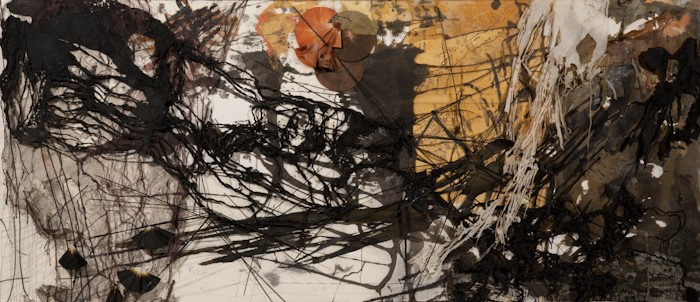
North Wind, 2010
Japanese papers, printed matter, artifica flowers, umbrella ribs, fabric, and coffee filters on paper, 48 11/16 × 108 5/8 × 5 1/16inches
Gift of the Lipman Family Foundation
Judy Pfaff
Born 1946, London
Lives and works in Kingston and Tivoli, New York
Influenced by European Dadaist installations that combined painting, sculpture, and photography, Judy Pfaff pioneered the emergence of installation art in the United States during the 1970s. In her colorful and richly textural installations and mixed-media work on paper, Pfaff incorporates diverse and intricate visual elements to form an organic and cohesive whole that is intensely energetic.
In North Wind, she used successive layers of ink, printed matter, and found objects to create a vibrant and complex cacophony of forms and images that are in and out of focus. By dismantling the fabric and mechanical components of an umbrella to look like branches and reusing coffee filters as leaves, Pfaff calls attention to nature’s destructive force and regenerative capability.
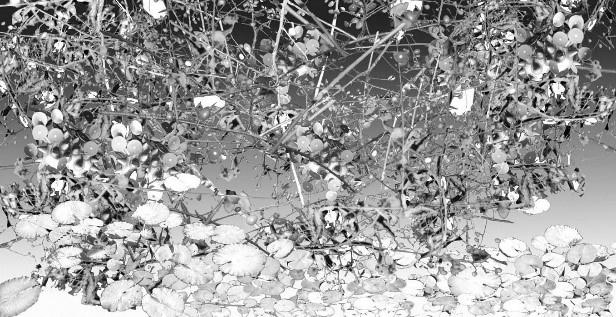
False Branches #2, 2001
Gelatin silver print, Edition 3 of 6, 21 × 40 inches
Gift of Jed Archer Cohen
Alyson Shotz
Born 1964, Glendale, Arizona
Lives and works in Brooklyn, New York
Fascinated by physics, Alyson Shotz considers space, light, optics, and gravity in her artistic process. In her “False Branches” series, Shotz addressed the human impulse to manage and control nature through science and technology by modifying images of plants, flowers, and other organic forms. With the help of a computer, Shotz created futuristic hybrid organisms that sprout not only leaves and flowers, but also lily pads, cactus spines, and fungi. Her mutated renderings recall recent experiments in cloning and current practices in genetic engineering. By rejecting idealized representations of nature, Shotz challenged our perceptions of what is possible or impossible, true or false.
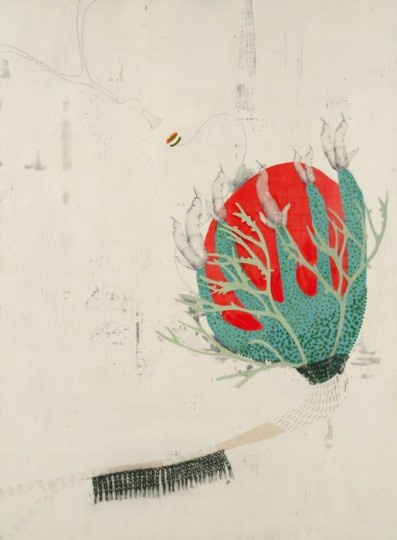
Orbis Erythromite, 2009
Oil, acrylic, graphite, and wax on ragboard, 30 × 22 inches
Museum purchase with funds contributed by Barbara and William Hyland
Kirsten Stolle
Born 1967, Newton, Massachusetts
Lives and works in Ashville, North Carolina
Kirsten Stolle examines the overuse of chemical fertilizers on our food supply and ponders the effects of climate change on the environment. As part of her “Global Flora Discovery Project,” Stolle created a futuristic compendium of plant species from the years 2050 until 2150 that either went extinct or mutated into other forms. She recorded her “findings” in playful mixed-media abstractions meant to resemble oversized botanical illustrations found in scientific journals.
In one such specimen, Orbis Erythromite, Stolle showed the plant as if suspended in mid-air: the bulbous, red bloom expands within its protective exoskeleton while a spindly appendage floats toward an unidentifiable object. Viewers are left to question the plant’s purpose, the habitat in which it thrives, and their own vision for the future of our planet.
